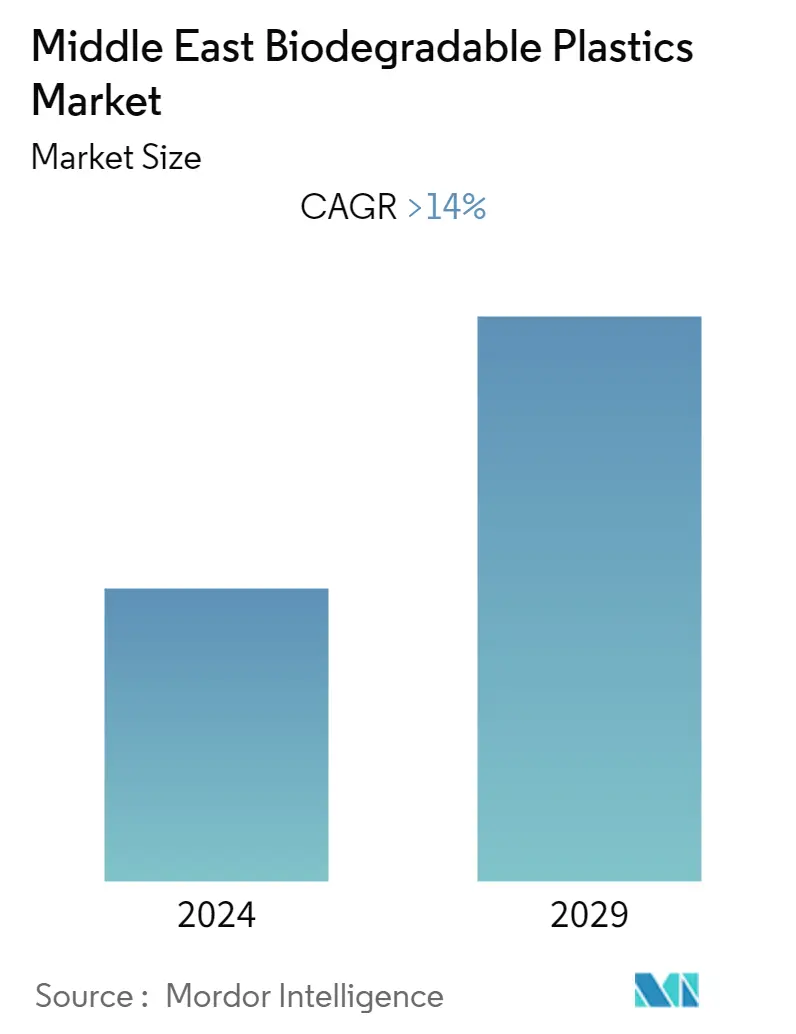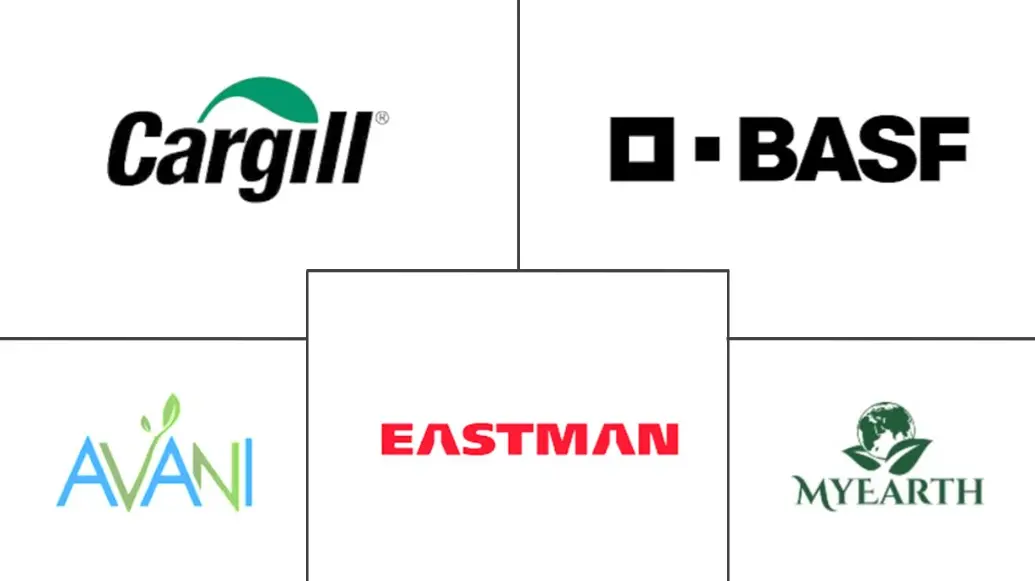Market Size of Middle East Biodegradable Plastics Industry

| Study Period | 2019 - 2029 |
| Base Year For Estimation | 2023 |
| Forecast Data Period | 2024 - 2029 |
| Historical Data Period | 2019 - 2022 |
| CAGR | 14.00 % |
| Market Concentration | Medium |
Major Players
*Disclaimer: Major Players sorted in no particular order |
Middle East Biodegradable Plastics Market Analysis
The Middle-East Biodegradable Plastics Market is projected to register a CAGR of over 14% during the forecast period. The market was negatively impacted by COVID-19 in 2020, owing to supply chain interruptions, a lack of raw materials utilized in the manufacturing process, workforce shortages, and fluctuating pricing. These factors caused the final product's production to inflate and go over budget due to the implications of lockdown. However, conditions improved in 2021, with the packaging industry's expansion stimulating demand for the biodegradable plastic market in the coming years.
- A major factor driving the market studied is the environmental issues encouraging an alternative to single-use plastic and promoting bioplastics. Additionally, the growing demand for packaging is likely to affect the market's growth.
- However, the availability of cheaper alternatives is likely to hamper the market's growth.
Recent research in biodegradable products led to a product that is easily soluble in water in under three days. New products with the shortest time to degrade after disposal will provide market growth opportunities.
Middle East Biodegradable Plastics Industry Segmentation
Bio-degradable plastics are plastics that can be decomposed by living organisms like microbes or in other specific conditions. The bio-degradable plastics market is segmented by application and geography. By application, the market is segmented into flexible packaging, rigid packaging, automotive and assembly operations, agriculture and horticulture, construction, textiles, electrical and electronics, and other applications. The report also covers the market size and forecasts for the bio-degradable plastic for each segment, the market sizing and forecasts have been done on the basis of volume (kilo tons).
| Type | |
| Strach based | |
| Polylactic Acid (PLA) | |
| Other Types |
| Application | |
| Packaging | |
| Other Applications |
| Geography | |
| United Arab Emirates | |
| Saudi Arabia | |
| Qatar | |
| Iran | |
| Rest of Middle East |
Middle East Biodegradable Plastics Market Size Summary
The Middle East biodegradable plastics market is experiencing significant growth, driven by increasing environmental concerns and government initiatives aimed at reducing single-use plastics. The market, which faced challenges during the COVID-19 pandemic due to supply chain disruptions and raw material shortages, has rebounded with the packaging industry playing a crucial role in its expansion. The demand for biodegradable plastics is particularly strong in the packaging sector, where they are used for both flexible and rigid applications, including organic and premium product packaging. Government policies in the region, such as bans on single-use plastics and incentives for sustainable alternatives, have further bolstered market growth. The introduction of innovative biodegradable products, such as those made from starch and other eco-friendly materials, is expected to provide additional growth opportunities.
The United Arab Emirates (UAE) stands out as a key player in the region's biodegradable plastics market, with significant economic activities and initiatives promoting the use of biodegradable materials. The UAE has implemented a complete ban on single-use plastic bags and is actively promoting biodegradable alternatives through various measures, including tariffs on plastic bags. Local companies are increasingly adopting biodegradable materials in their products, such as cornstarch-based packaging solutions. The market is partially consolidated, with major players like BASF SE, Cargill Incorporated, and Ecoway Biopolymers LLC contributing to the industry's development. Recent investments and partnerships, such as those involving Avani Eco and Symphony Environmental Technologies, are expected to enhance the production and application of biodegradable plastics in the region, supporting the market's growth trajectory over the forecast period.
Middle East Biodegradable Plastics Market Size - Table of Contents
-
1. MARKET DYNAMICS
-
1.1 Drivers
-
1.1.1 Environmental Factors Encouraging a Paradigm Shift
-
1.1.2 Growing Demand for Bioplastics in Packaging
-
-
1.2 Restraints
-
1.2.1 Availability of Cheaper Alternatives
-
1.2.2 Other Restraints
-
-
1.3 Porter's Five Forces Analysis
-
1.3.1 Bargaining Power of Suppliers
-
1.3.2 Bargaining Power of Buyers
-
1.3.3 Threat of New Entrants
-
1.3.4 Threat of Substitute Products and Services
-
1.3.5 Degree of Competition
-
-
-
2. MARKET SEGMENTATION
-
2.1 Type
-
2.1.1 Strach based
-
2.1.2 Polylactic Acid (PLA)
-
2.1.3 Other Types
-
-
2.2 Application
-
2.2.1 Packaging
-
2.2.2 Other Applications
-
-
2.3 Geography
-
2.3.1 United Arab Emirates
-
2.3.2 Saudi Arabia
-
2.3.3 Qatar
-
2.3.4 Iran
-
2.3.5 Rest of Middle East
-
-
Middle East Biodegradable Plastics Market Size FAQs
What is the current Middle East Biodegradable Plastics Market size?
The Middle East Biodegradable Plastics Market is projected to register a CAGR of greater than 14% during the forecast period (2024-2029)
Who are the key players in Middle East Biodegradable Plastics Market?
BASF SE , Cargill Incorporated, Eastman Chemical Company , KiSabz (Maadiran) and Ecoway Biopolymers LLC are the major companies operating in the Middle East Biodegradable Plastics Market.

